As much as we love PRINCE2®, we will admit that the PRINCE2 manual can be a bit dry!
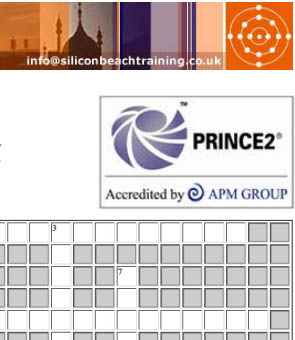 We've put together a PRINCE2 Crossword to Download to help enliven your revision a bit!
We've put together a PRINCE2 Crossword to Download to help enliven your revision a bit!
BEFORE YOU COMPLETE THE CROSSWORD: Read through the statements in this PRINCE2 Crossword Revision post.
You can also download the solution to check your answers at the bottom of the revision post (but no cheating please)!!
We're committed to making learning PRINCE2 as easy and enjoyable as possible - so before you attend one of our PRINCE2 courses we provide a comprehensive pre-course workbook which contains loads of quizzes and guidance to make preparing for the course as interactive as we can.
Why not also try our Interactive PRINCE2 Quiz (you'll need Flash for this).
Andy Trainer
15 Jul 2011
To be effective in your work means doing the right things (effectiveness) in the right way (efficiency); this involves being clear about the key result areas of your job and the precise outputs required. Planning is central to time management, but it is not the first step. You must first know what it is you are planning. What is your work or, more correctly, what should your work be? If you are to plan you must plan to do the right things. Learn how to achieve key results in time management on our 1-day Time Management Course.
What are Key Result Areas?
These are the major overall things your organisation expects you to achieve. In other words, your purpose or why I am here. They may be reflected in your job description; they may be given to you as objectives or targets. You may have your own professional/personal result areas too.
Once you are clear on your Key Result Areas, you can go to plan your work practices more efficiently as all of your objectives should relate back to them. This means that you will never again be involved in activities that are outside the scope of your job and, therefore, a waste of your time!
Make a list of your key result areas NOW!
When you have that list you can divide it into tasks as follows:
- Active Positive Tasks
- Reactive Maintenance Tasks
Active Positive Tasks
So-called because they bring you and your long-term objectives forward. They are neither urgent nor obvious - they require justification, creativity and special effort. Planning, developing new projects or devising new procedures are examples of these tasks; if they are not performed, effects are not immediately obvious BUT their achievement will be directly in line with the achievement of your Key Result Areas.
Reactive Maintenance Tasks
These are the tasks which are probably the most visible part of your job; the day to day routine aspects of your work. Such tasks are usually urgent and quantifiable - individual steps in the process are clear. Such tasks do not require justification - they are part of normally accepted procedure. If these tasks are not done properly or on time, the effects are obvious to others. Reading your emails, doing routine reports are examples of this type of task. These tasks are called maintenance tasks because they maintain things as they are.
Effective time management is about the ability to balance and prioritise.
Make a list of your Active Positive Tasks and your Reactive Maintenance Tasks. Then review your lists:
- What percentage of your time do you spend on each?
- How happy are you with this?
- How can you bring about change in these areas?
Whilst we cannot always change the things that adversely impact upon our working day – interruptions, time wasters - we can control our own behaviour. Bringing about improvements in time management is essentially about changing our behaviour and implementing new techniques and habits.
Andy Trainer
26 Oct 2007
To be effective in your work means doing the right things (effectiveness) in the right way (efficiency); this involves being clear about the key result areas of your job and the precise outputs required. Planning is central to time management, but it is not the first step. You must first know what it is you are planning. What is your work or, more correctly, what should your work be? If you are to plan you must plan to do the right things. Learn how to achieve key results in time management on our 1-day Time Management Course.
What are Key Result Areas?
These are the major overall things your organisation expects you to achieve. In other words, your purpose or why I am here. They may be reflected in your job description; they may be given to you as objectives or targets. You may have your own professional/personal result areas too.
Once you are clear on your Key Result Areas, you can go to plan your work practices more efficiently as all of your objectives should relate back to them. This means that you will never again be involved in activities that are outside the scope of your job and, therefore, a waste of your time!
Make a list of your key result areas NOW!
When you have that list you can divide it into tasks as follows:
- Active Positive Tasks
- Reactive Maintenance Tasks
Active Positive Tasks
So-called because they bring you and your long-term objectives forward. They are neither urgent nor obvious - they require justification, creativity and special effort. Planning, developing new projects or devising new procedures are examples of these tasks; if they are not performed, effects are not immediately obvious BUT their achievement will be directly in line with the achievement of your Key Result Areas.
Reactive Maintenance Tasks
These are the tasks which are probably the most visible part of your job; the day to day routine aspects of your work. Such tasks are usually urgent and quantifiable - individual steps in the process are clear. Such tasks do not require justification - they are part of normally accepted procedure. If these tasks are not done properly or on time, the effects are obvious to others. Reading your emails, doing routine reports are examples of this type of task. These tasks are called maintenance tasks because they maintain things as they are.
Effective time management is about the ability to balance and prioritise.
Make a list of your Active Positive Tasks and your Reactive Maintenance Tasks. Then review your lists:
- What percentage of your time do you spend on each?
- How happy are you with this?
- How can you bring about change in these areas?
Whilst we cannot always change the things that adversely impact upon our working day – interruptions, time wasters - we can control our own behaviour. Bringing about improvements in time management is essentially about changing our behaviour and implementing new techniques and habits.
Andy Trainer
26 Oct 2007
PRINCE2® PROCESSES – Starting Up a Project (SU)
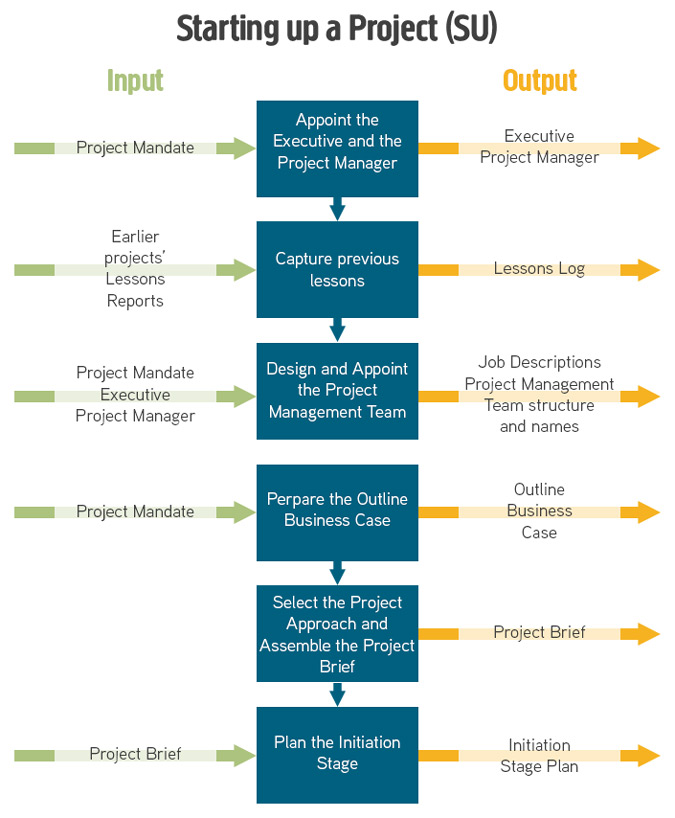
The purpose of the Starting up a Project process is to ensure that the prerequisites for Initiating a Project are in place by answering the question: do we have a viable and worthwhile project?
This process is triggered by a mandate and is designed to establish the following:
- There is a business justification for initiating the project (documented in an outline Business Case)
- All the necessary authorities exist for initiating the project
- Sufficient information is available to define and confirm the scope of the project (in the form of a Project Brief)
- The various ways the project can be delivered are evaluated and a project approach selected
- Individuals are appointed who will undertake the work required in project initiation and/or will take significant project management roles in the project
- The work required for project initiation is planned (documented in a Stage Plan)
- Time is not wasted initiating a project based on unsound assumptions regarding the project’s scope, time scales, acceptance criteria, and constraints.
Products produced during this process are as follows:
- Role descriptions
- Daily Log
- Lessons Log
- Outline Business Case
- Project Product Description
- Project Approach
- Project Brief
- Stage Plan
The PRINCE2 processes are covered in detail in our PRINCE2 Foundation training and PRINCE2 Practitioner training courses in Brighton, Sussex.
Andy Trainer
12 Jul 2007
PRINCE2® PROCESSES – Closing a Project (CP)
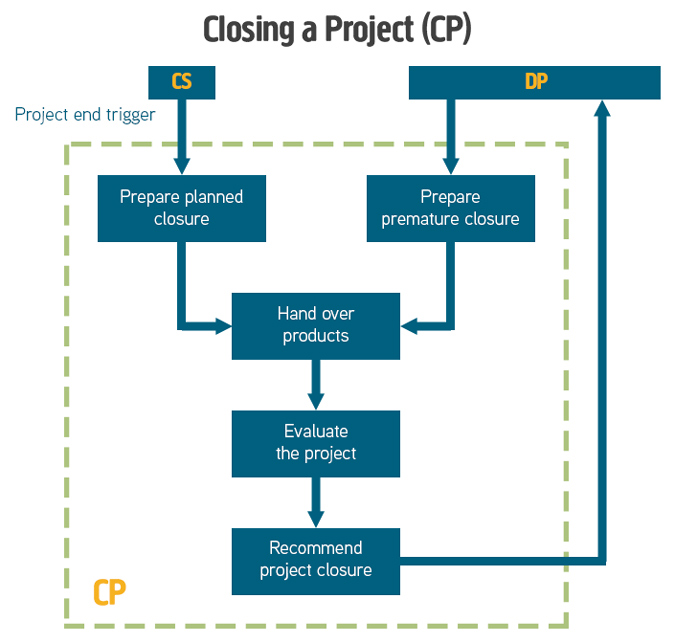
See our courses for PRINCE2.
The purpose of the Closing a Project process is to provide a fixed point at which acceptance for the project product is confirmed and to recognize that objectives set out in the original Project Initiation Documentation have been achieved (or approved changes to the objectives have been achieved), or that the project has nothing more to contribute.
The objective of the Closing a Project process is to:
- Verify user acceptance of the project’s products
- Ensure that the host site is able to support the products when the project is disbanded
- Review the performance of the project against its baselines
- Assess any benefits that have already been realized, update the forecast of the remaining benefits, and plan for a review of those unrealized benefits
- Ensure that provision has been made to address all open issues and risks, with follow-on action recommendations.
The main products of this process are as follows:
- Project Plan updated with final actual
- Product Status Account covering the status of all products for the project
- Issue register to identify any outstanding issues
- Follow-on action recommendations created with any outstanding issues to be addressed
- Configuration item records updated with current status of products
- Benefits review plan updated with dates for benefits realization
- Acceptance records for products completed
- End project report created
- Lessons Report created
- Close Issue, Risk, Quality registers, Daily and Lessons Log
Andy Trainer
12 Jul 2007
PRINCE2® PROCESSES – Managing Product Delivery (MP)
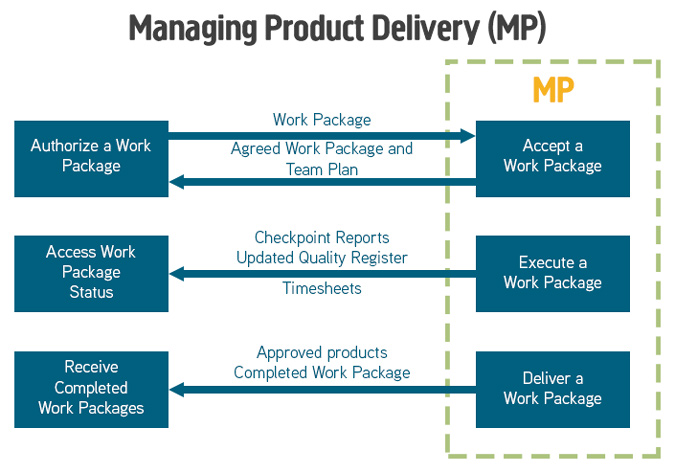
The purpose of the Managing Product Delivery process is to control the link between the Project Manager and the Team Manager(s), by placing formal requirements on accepting, executing and delivering project work.
The role of the Team Manager(s) is to coordinate an area of work that will deliver one or more of the project’s products. They can be internal or external to the customer’s organisation.
The objective of the Managing Product Delivery process is to ensure that:
- Work on products allocated to the team is authorised and agreed.
- Team Managers, team members and suppliers are clear as to what is to be produced and what is the expected effort, cost or timescales.
- The planned products are delivered to expectations and within tolerance.
- Accurate progress information is provided to the Project Manager at an agreed frequency to ensure that expectations are managed.
Products that are created or updated during this process are:
- Team plans with actual dates.
- Risk register with any identified work package level risks.
- Quality register with all quality work that is being undertaken.
- Configuration Item Records with the latest status of products produced.
- Project Issues with status information and impact analysis for current or new issues identified.
- Checkpoint Reports providing regular progress information to the Project Manager.
Silicon Beach Training is an accredited training organisation for PRINCE2 Training.
Andy Trainer
12 Jul 2007
PRINCE2® PROCESSES – Controlling a Stage (CS)
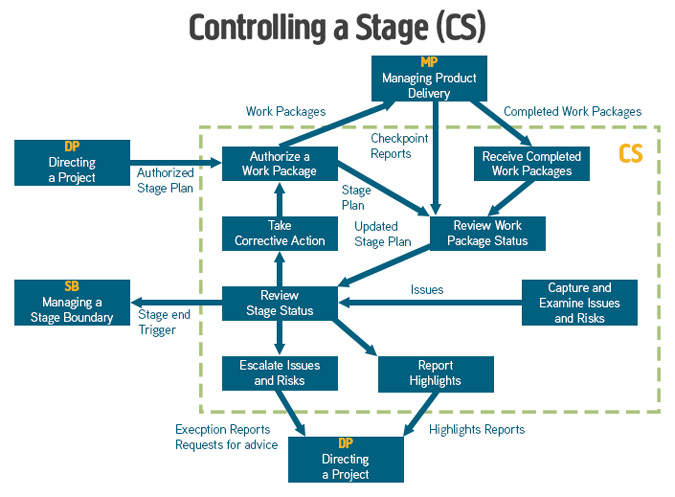
The purpose of the Controlling a Stage process is to assign work to be done, monitor such work, deal with issues, report progress to the Project Board, and take corrective actions to ensure that the stage remains within tolerance.
For each stage, the following cycle of activities will be covered:
- Authorise a Work Package
- Review Work Package Status
- Receive Completed Work Packages
- Review the stage status
- Report highlights
- Capture and examine issues and risks
- Escalate issues and risks
- Take correction action
The continued assessment of risk and issues during this process is important.
Products used or produced during this process:
- Work packages, detailing the products to be produced must be agreed between Project and Team Manager.
- Quality register – checked for approved products produced
- Configuration item records – updated with the latest status of products
- Checkpoint reports – reviewed in preparation for Highlight reports
- Highlight Reports (time-driven control) produced by the Project Manager, sent to the Project Board advising on progress information.
- Issue reports and Issues register in which all issues are captured and examined.
- Daily log – used to informally manage any risks and issues
- Lessons Log – updated with any lessons learned during the stage
- Updated Risk register.
- The Stage Plan which is regularly updated with actual achievements.
- An Exception Report may also need to be created if an issue is forecast to exceed stage tolerances.
Learn more about the Controlling a Stage Process on our PRINCE2 Courses.
Andy Trainer
12 Jul 2007
PRINCE2® PROCESSES - Managing a Stage Boundary
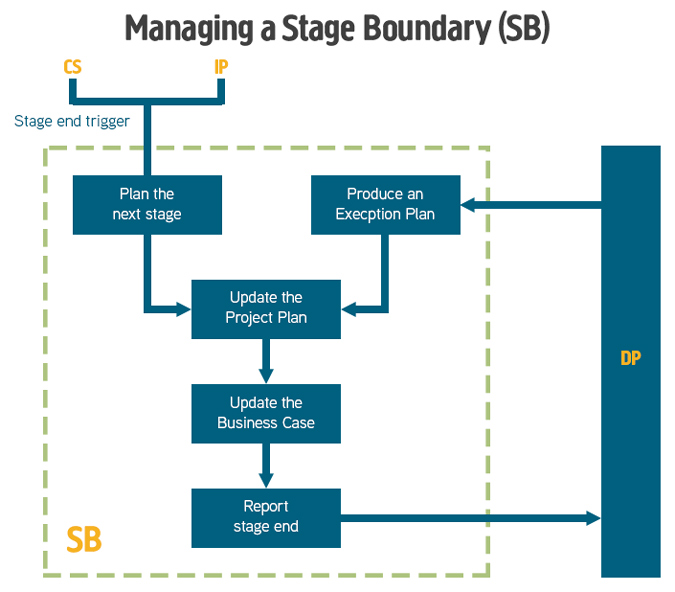
The purpose of the Managing a Stage Boundary process is to enable the Project Board to be provided with sufficient information by the Project Manager so that it can review the success of the current stage, approve the next Stage Plan, review the updated Project Plan, and confirm continued business justification and acceptability of the risks. Therefore, the process should be executed at, or close to the end of, each management stage. The PRINCE2 Processes are covered in detail on our PRINCE2 Foundation training and PRINCE2 Practitioner training courses.
The objective of the Managing a Stage Boundary process is to:
- Assure the Project Board that all products in the Stage Plan for the current stage have been completed and approved
- Prepare the Stage Plan for the next stage
- Review and, if necessary, update the Project Initiation Documentation (in particular the Business Case, Project Plan, project approach, strategies, project management team structure, and role descriptions)
- Provide the information needed for the Project Board to assess the continuing viability of the project – including the aggregated risk exposure
- Record any information or lessons that can help later stages of this project and/or other projects
- Request authorization to start the next stage.
The main products of this process are as follows:
- An End Stage Report produced by the Project Manager and given to the Project Board, outlining information on the current stage achievements.
- Current Stage Plan actuals showing the performance against the original Stage Plan.
- The Next Stage or Exception Plan for approval.
- Project Initiation Documentation may require updating.
- A revised Project Plan incorporating all the actual metrics.
- An updated Risk register, together with the Updated Business Case and Project Plan, which is used by the Project Board to review that the Project has continuing ongoing viability.
- Configuration item records created/updated for new stage products.
- An updated Business Case.
- The Lessons Log.
- Any changes to the Project Management Team with updated Job Descriptions.
Team plans may also be produced when planning the next stage, defining the work packages that will be produced in the next stage.
Andy Trainer
12 Jul 2007